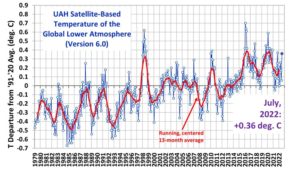by Net Zero, Jan 13, 2023 NetZeroWatch
-
Each year, we invite Net Zero Watch readers to enter our annual Global Temperature Prediction Competition, in which we try to outdo the Met Office for the accuracy of our soothsaying.
-
For 2022, the Met Office predicted an average of between 0.97 and 1.21°C (midpoint 1.09°C) above pre-industrial temperatures for the HadCRUT5 index. However, Net Zero Watch readers, as is their wont, went slightly lower, with the median prediction coming in at 1.00°C, and the mode at 1.03°C. This is all shown in the graph below, alongside the correct value, just announced by the Met Office, of 1.16°C.

As you can see, none of our competition entrants got the right answer. There were three people just above, and three more just below. We’ll put all six names into a hat to pick a winner. We’ll be in contact shortly.
If you’d like to enter the 2023 competition, now is your chance!
As always, the prize is a bottle of hooch of your choice, and a book from the GWPF or Net Zero Watch publication lists.
The Met Office reckons on a relatively sharp warming, suggesting HadCRUT5 will come in at between 1.08 and 1.32°C above pre-industrial (with a central estimate of 1.20°C). That’s 0.04°C above last year’s outturn, which doesn’t seem unreasonable, assuming we come out of the La Nina conditions that prevailed in 2022.
To enter, click here (opens a new site). Good luck!




 Figure 1: UAH global temperature anomaly
Figure 1: UAH global temperature anomaly


